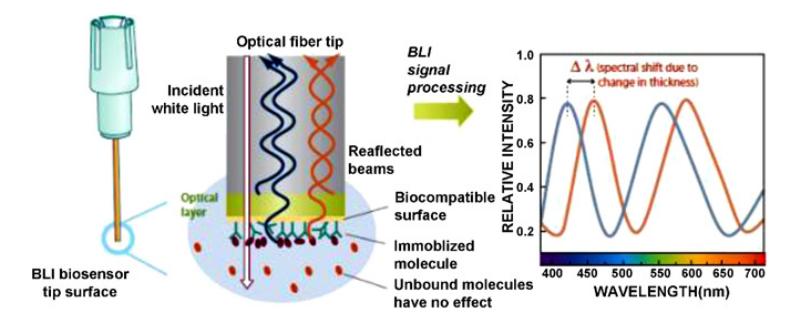Bio-Layer Interferometry (BLI)
Online Inquiry
Bio-layer interferometry (BLI) is a high-throughput technology used to study the functional activity associated with antibody drugs. Creative Proteomics utilizes BLI technology to help our clients gain information about the binding kinetics and affinity of their antibody drugs to improve their development, selection and optimization.
Principle of BLI technology
BLI technology is based on the principle of light interference, in which a thin layer of biomolecular compatible fiber optic film is wrapped around the top surface of the biosensor probe. When visible light passes through the sensor's fiber optic membrane, it is reflected at two surfaces in the membrane layer, and the resulting two reflected light beams are further interfered with to form the original interference pattern. When a ligand is coupled to the membrane by different forces, the thickness of the membrane changes and a new interference pattern is formed when visible light passes through. Compared to the previous pattern, the shift of the new pattern reflects the change in thickness of the membrane layer. At this point, the BLI instrument can be used to monitor relative shift changes in real time and convert them into system-specific parameters and maps, including binding constants (ka or kon) and dissociation constants (kd or koff), as well as binding rate onset, and analyze them by fitting calculations to obtain affinity (KD) and concentration information.
 Fig. 1 Principle of the ForteBio BLI technique. (Wallner, J. et al., 2013)
Fig. 1 Principle of the ForteBio BLI technique. (Wallner, J. et al., 2013)
Our BLI-Based Antibody Drugs Characterization Services
Bio-layer interferometry (BLI) is a powerful analytical technique commonly used in our laboratory to study biomolecular interactions. BLI allows us to monitor and analyze antigen-antibody interactions in real time and quantify their binding strength and kinetics, helping our clients to accurately assess the quality and efficacy of their antibody therapies.
Our services for the characterization of antibody drugs based on the BLI technology include the following:
Antibody-target binding kinetics determination
The kinetics of a drug molecule binding to its target is one of the vital parameters considered during the selection of a lead therapeutic agent. In the binding assay, we immobilize the antibody molecule to be detected on the surface of the biosensor and monitor in real time the changes in the interference pattern as the target binds to the antibody molecule. By rapidly determining key kinetic parameters such as binding rate (ka), dissociation rate (kd), and equilibrium dissociation constant (KD), we can accurately assess antibody-antigen interactions and provide a comprehensive analysis of the potency and specificity of antibody drugs.
Antibody affinity determination
Affinity represents the strength of the binding interaction. This information is critical for evaluating the potency and specificity of antibody drugs. We use BLI technology to monitor the binding and dissociation phases of the binding process to obtain affinity measurements that provide accurate quantitative affinity data.
Advantages of Our Bio-Layer Interferometry Technology
- Label-free analysis.
- Real-time data monitoring: data on the kinetics of intermolecular interactions can be detected in real time.
- Low assay usage: only a small nanomolar amount of sample is required, which can be used to analyze molecular samples that are difficult to separate.
- Wide range of applications: direct detection of raw samples and even the presence of insoluble components in the sample, resistant to various solution environments, only molecules bound to the sensor surface are detected.
- High throughput detection: simple and fast experimental procedure.
- Precise results: fine quantitative analysis and access to kinetic parameters for more biological information.
Creative Proteomics uses bio-layer interferometry technology to provide you with information about the functional activity of your antibody drug product. Our dedicated team of experts will assist you throughout the entire process, from initial experimental design to data analysis. Contact us to learn more about our service and we will be happy to serve you.
Reference
- Wallner, J.; et al. Application of Bio-Layer Interferometry for the analysis of protein/liposome interactions. Journal of pharmaceutical and biomedical analysis. 2013, 72: 150-154.

 Fig. 1 Principle of the ForteBio BLI technique. (Wallner, J. et al., 2013)
Fig. 1 Principle of the ForteBio BLI technique. (Wallner, J. et al., 2013)